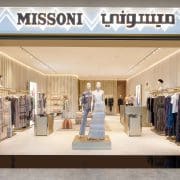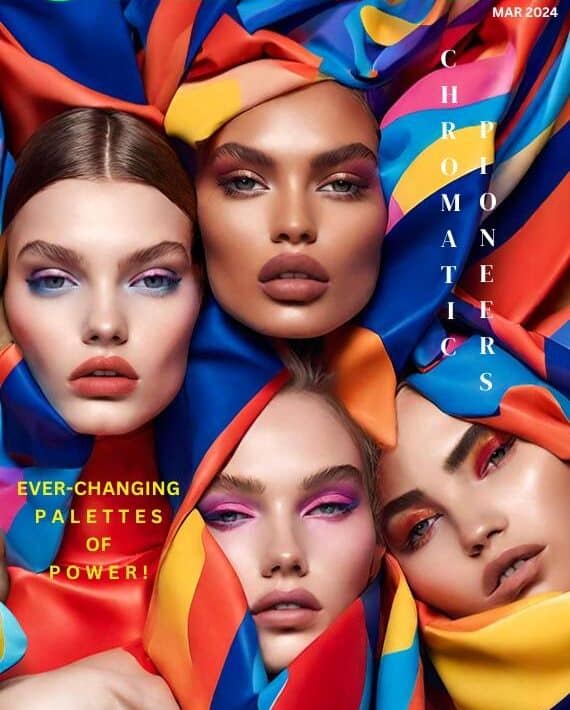“From the Heart to the Hands: Dolce & Gabbana”: A Take on The Unprecedented Fashion Exhibition Celebrating The Italian Splendour Through History, Art, Architecture, Cinema, Theatre and Music


“From the Heart to the Hands”, the one of a kind exhibition showcasing Dolce&Gabbana’s unique creations, has closed its doors after more than three months of stay in Milan, leaving an indelible memory in the minds of the thousands of visitors who had the chance to admire the works of art of the emblazoned Italian House.
The Grand Tour of Italian Splendour, finely curated by Art Historian and Fashion Expert Florence Muller, is now on its way to international destinations, always asserting the fundamental principle that fashion is above all culture and creativity. Designers Domenico Dolce and Stefano Gabbana are referred to as icons of style and elegance: not only do they craft garments but they also weave narratives through fabrics, colors and details, upholding the Italian artisanal tradition with a spirit of innovation and passion.
“From the Heart to the Hands” is a multi-facets display representing Dolce&Gabbana’s style through an immersive journey embracing visual art, architecture, music, cinema, theatre and Italian traditions. The exhibit unfolds along ten themed rooms.
Handmade
The first room, dedicated to the “Fatto a Mano”, presents a selection of paintings by French-American artist, actress and model Anh Duong, known for her self-portraits, which she has compared to a visual diary, as well as portraits of significant art collectors and influencers. The paintings, created between 2012 and 2024, depict the artist herself dressed in emblematic items of the fashion house and pay homage to female beauty in all its diversity. However, a keen eye for details will recognize that those works are so much more than a mere self-representation in designer clothing as a tribute to the Italian house: the brushstrokes, the figurative technique, the color choices and the chromatic combinations, everything recalls Dolce&Gabbana’s aesthetics, so powerful, strong, vibrant, creating an all-round transposition with the designers’ styles.
The Art and Craft of Glassworking
The second room welcomes visitors with a series of finely crafted mirrors and chandelier of the Venetian glassworking. These creations have been designed to reflect the meticulous sequinned embroidery and crystal floral detailing that adorn the garments exhibited. But, again, we can find more. The play of light generated by the crystals is simply mesmerizing. Crystals act like a spectrum, showing a number of colors perceived by human eyes as a rainbow and giving life to an immersive experience where fashion, craft and color create in the vistors’ mind an explosion of feelings and emotions.
The Leopard
The third room is about cinema and it is a tribute to “The Leopard”, a recurring reference in the Dolce&Gabbana vision. Eight creations by Dolce&Gabbana, evoking Luchino Viscont’s famous movie (1963), based on the novel by Tomasi di Lampedusa, stand out in the center of the room. The setting is a faithful and evocative representation of the “Gallery of Mirrors” of Palazzo Gangi in Palermo, the iconic location of the famous ball scene in the cinematic masterpiece. Besides the fact that Sicily represents Dolce&Gabbana’s brand identity, with its culture, eclectic traditions and vibrant colors, the key to understanding why “The Leopard”, set during the Risorgimento, at the moment of the transition from the Bourbon Kingdom to the unification of Italy, became emblematic in the story of the Italian House might be another one. There is a moral in the book that well defines the Italian way of doing politics: “everything must change so that nothing changes” – “A bitter observation of how power has never changed hands but has instead changed its face. Likewise, while fashion trends and inspirations change through decades and centuries” (quotation taken from “Comune di Firenze, Estate Fiorentina, Teatro delle Donna, 2023”, free translation into English). Likewise, we might assume that, while fashion trends and inspirations change over the decades and centuries, true talent and elegance never quit: Dolce&Gabbana’s style will live forever.


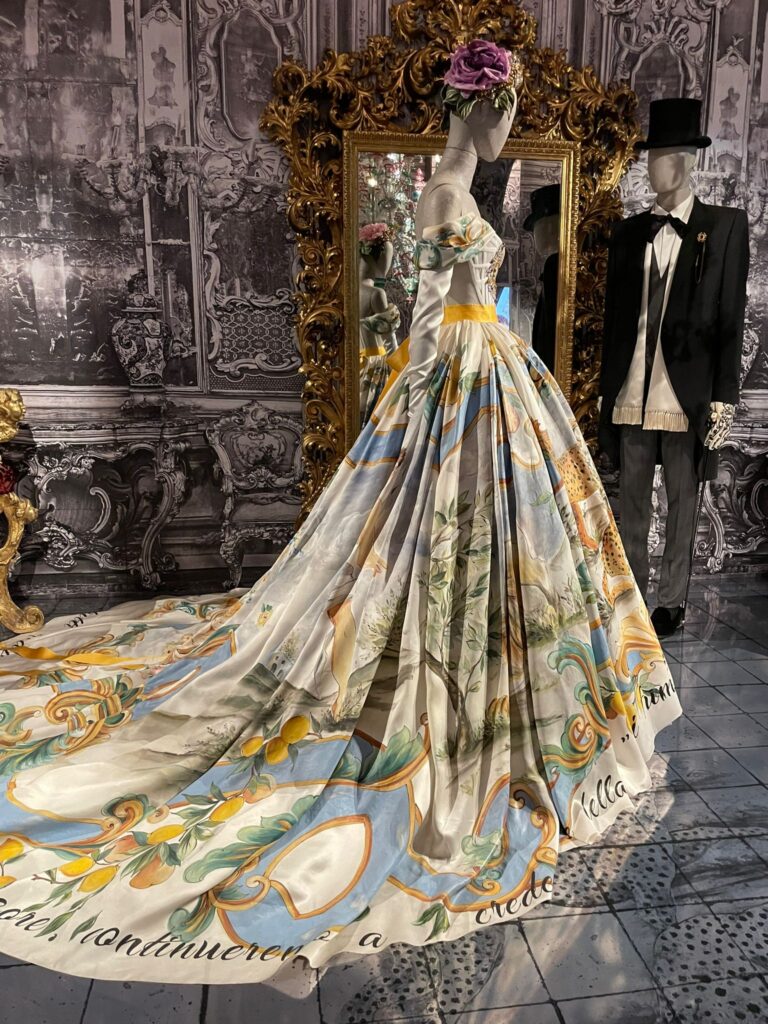
Devotion
Dedicated to the theme of devotion, the fourth room is steeped in a Baroque atmosphere: the “Sacred Heart”, a treasure chest that holds a selection of Alta Moda and Alta Gioielleria creations that alternate the charm of Sicilian black and the opulence of gold. Taking for granted that Baroque style, so elevated and pompous, perfectly fits Dolce&Gabbana’s aesthetics, what impresses the eye most is, once again, the chromatic choice: black and gold are combined to create a suggestive mystical atmosphere, while conveying the idea of devotion, mystery, power and luxury. Gold is a metal which never oxidizes. It has always had great value in human culture. Thanks to its sheen and preciousness, it is the most coveted of all colors. Its meaning is tied to success, wealth, nobility, timeless beauty and longevity and it is extensively used in places of religious devotion. Black is a color that unconsciously generates fear. Throughout history, especially in the Western tradition, black has always been symbol of death, used in funerals, taking on a religious connotation. Interesting to know that, until the late 1920s, black had never been used within fashion, as primarily linked to mourning. Its destiny changed when Chanel introduced a brand new paradigm for black with the iconic “little black dress”. From then on, the fashion industry adopted it as a symbol of sophistication and elegance. And this is exactly what we can perceive while observing Dolce&Gabbana’s masterpieces on the theme of Devotion.
Ateliers, ornaments and volumes
The heart of the exhibition is the fifth room, which provides an extraordinary glimpse into the workshop practice central to Dolce&Gabbana’s Alta Moda, Alta Sartoria and Alta Gioielleria. This space faithfully reproduces the ateliers and laboratories of the fashion House. It is so well curated that the impression visitors have is to see tailors, seamstresses and artisans working meticulously to complete Dolce&Gabbana’s timeless creations of inestimable value. A selection of precious fabrics of all types, accessories, trimmings, rhinestones, along with the presence of real sewing machines, some of which are truly museum-worthy, give the idea of how complex and hard the work “behind the scene” of fashion is. Entering this room you can profoundly understand why the exhibition has been entitled “From the Heart to the Hands”. The space is actually a metaphor of the process through which the designers’ creative flair is translated into wonderful works thanks to meticulous craftsmanship. Tailoring is a timeless art, passed down from generation to generation. It is an art that primarily resides, in defiance to the technology advances, in the heart and in the hands of those who put passion in it.
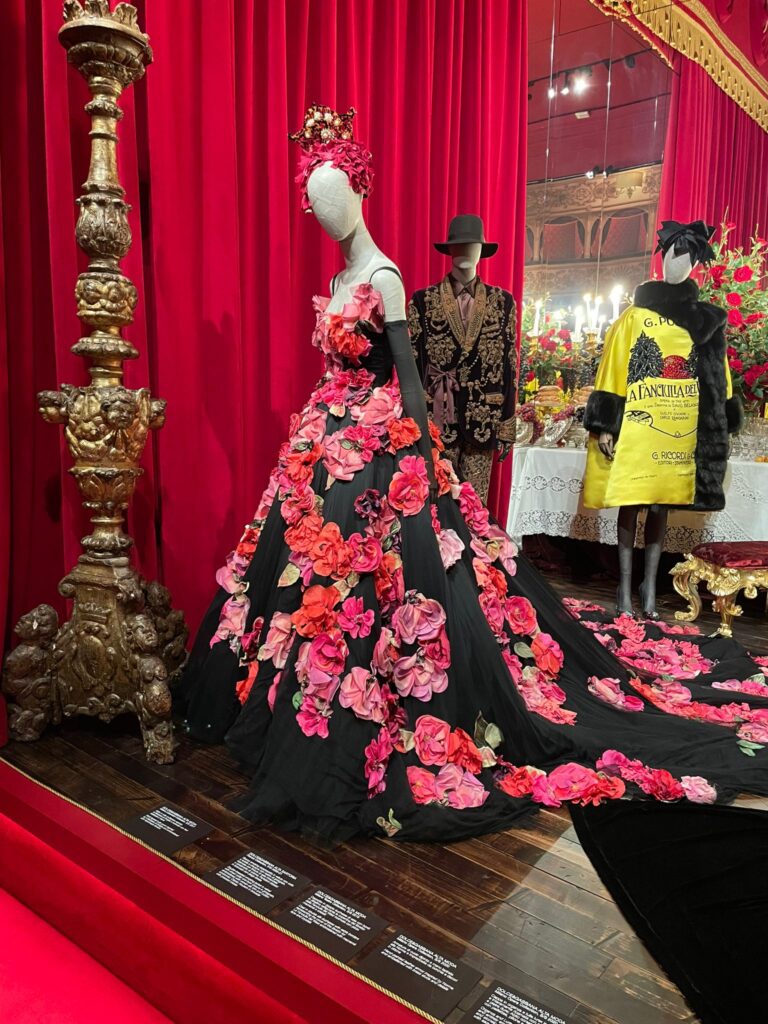
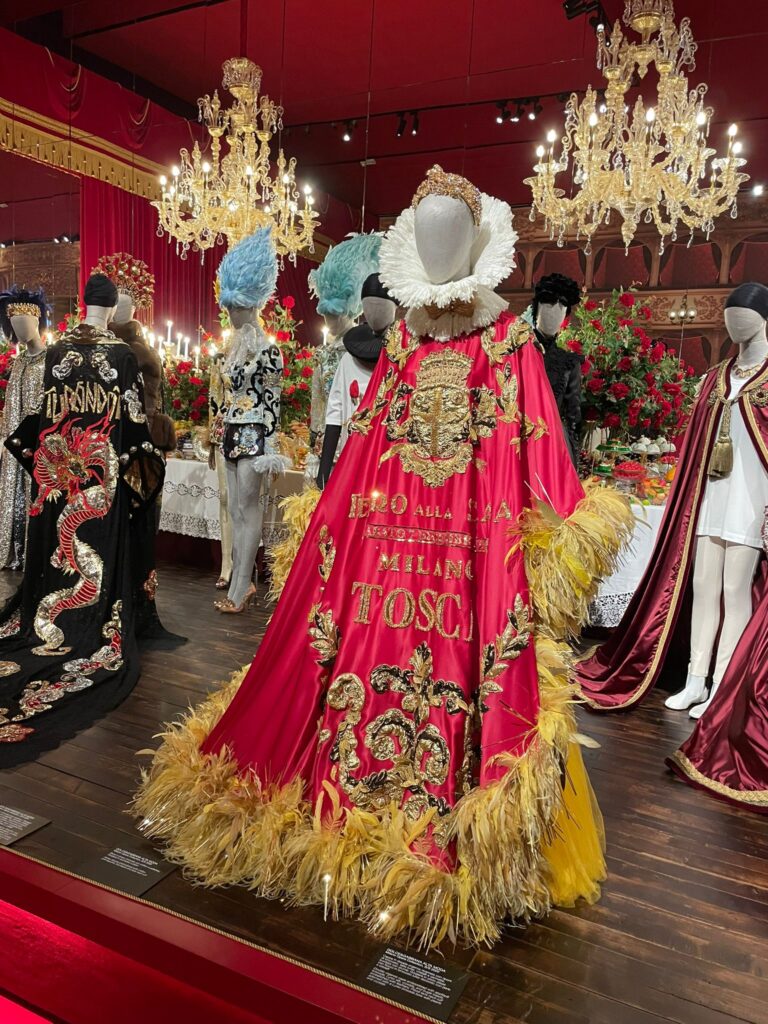
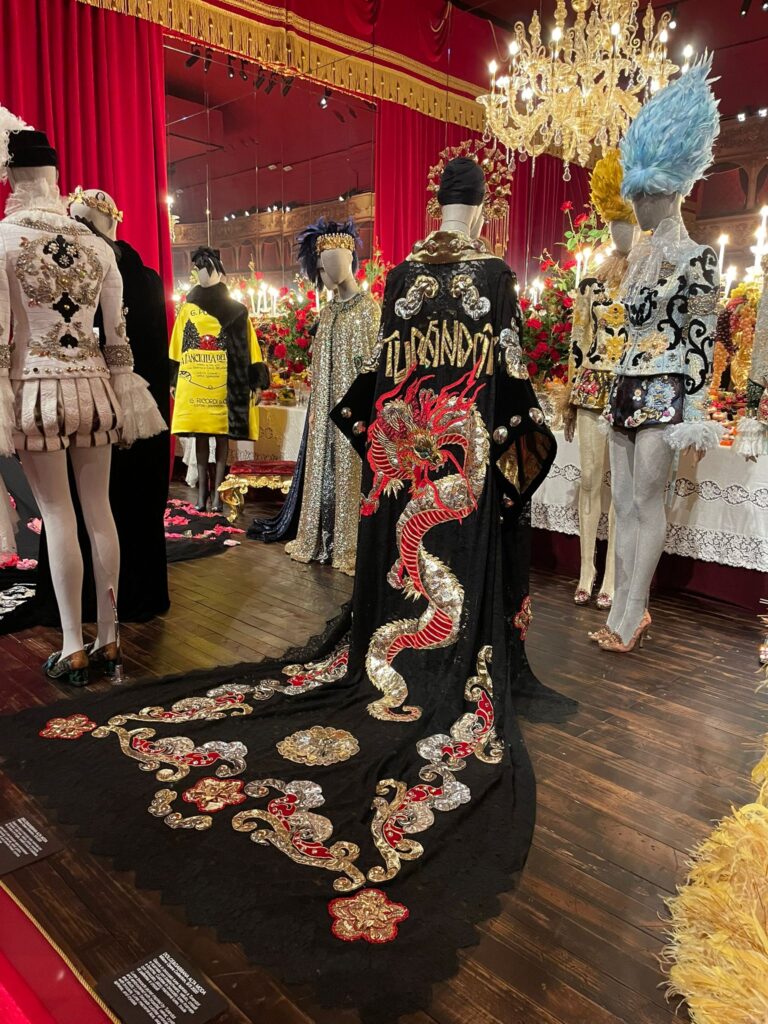

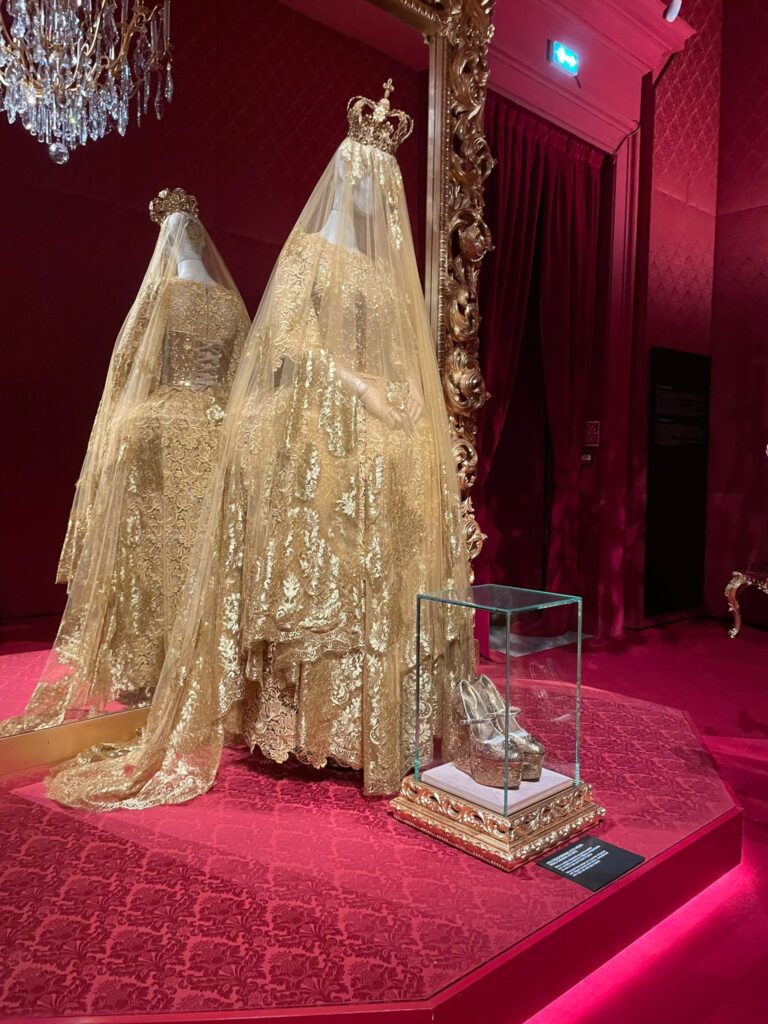
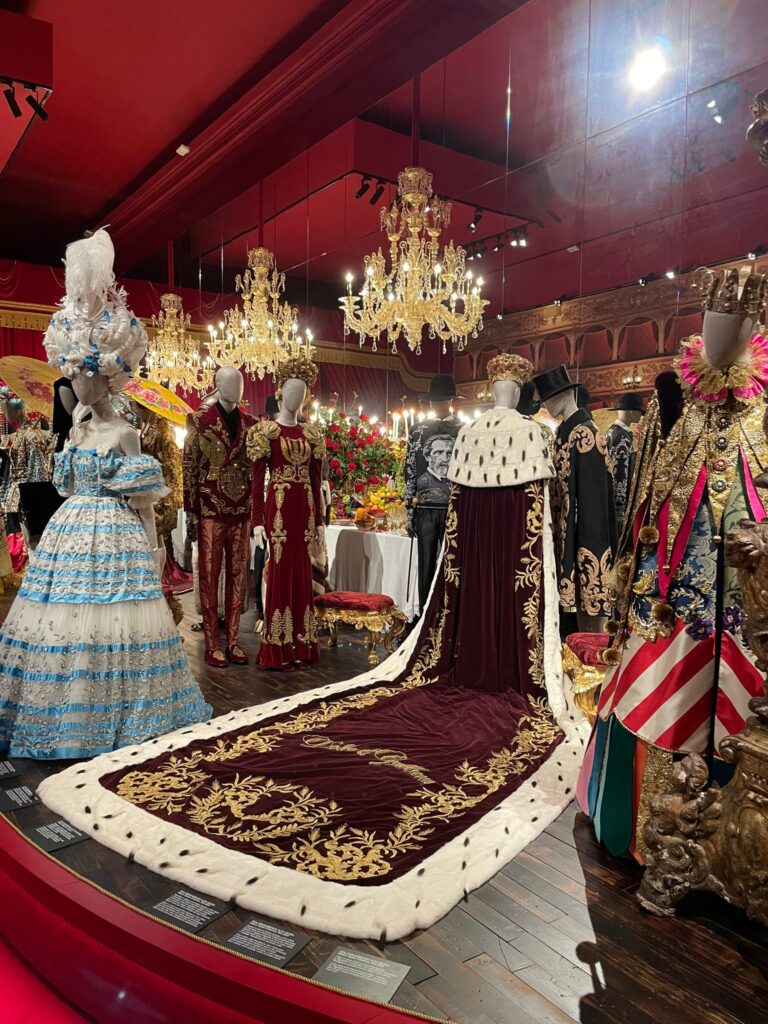
Architectural and pictorial
The tour continues with a parallel between art and architecture and painting. The message behind this installation is: building a garment is almost like building a house. The architect begins with a series of sketches to define shapes and volumes, in the same way the stylist traces the lines of a dress before it comes to life. Visitors are immersed in a space with a unique atmosphere, where a sophisticated mapping technique projects images of the beautiful frescoes of Palazzo Farnese in Rome, tracing back to the end of the sixteenth century. In the center of the room, a series of creations inspired by the great masters of Italian Renaissance loved by Domenico Dolce and Stefano Gabbana are displayed.
Sicilian Traditions
The wealth of Sicilian craft tradition comes to life in the seventh room through a special installation of the colourful majolicas enriched by the presence of a typical Sicilian Cart. Here are showcased some of Dolce&Gabbana’s Alta Moda creations where the Sicilian symbols are translated into pattern for wearable art. All around the space a riot of vibrant colors representing the Italian island: from the yellow and orange of the citruses, to the blue of the sea and clear skies till the green of nature. Energy and traditions are the key words in here.
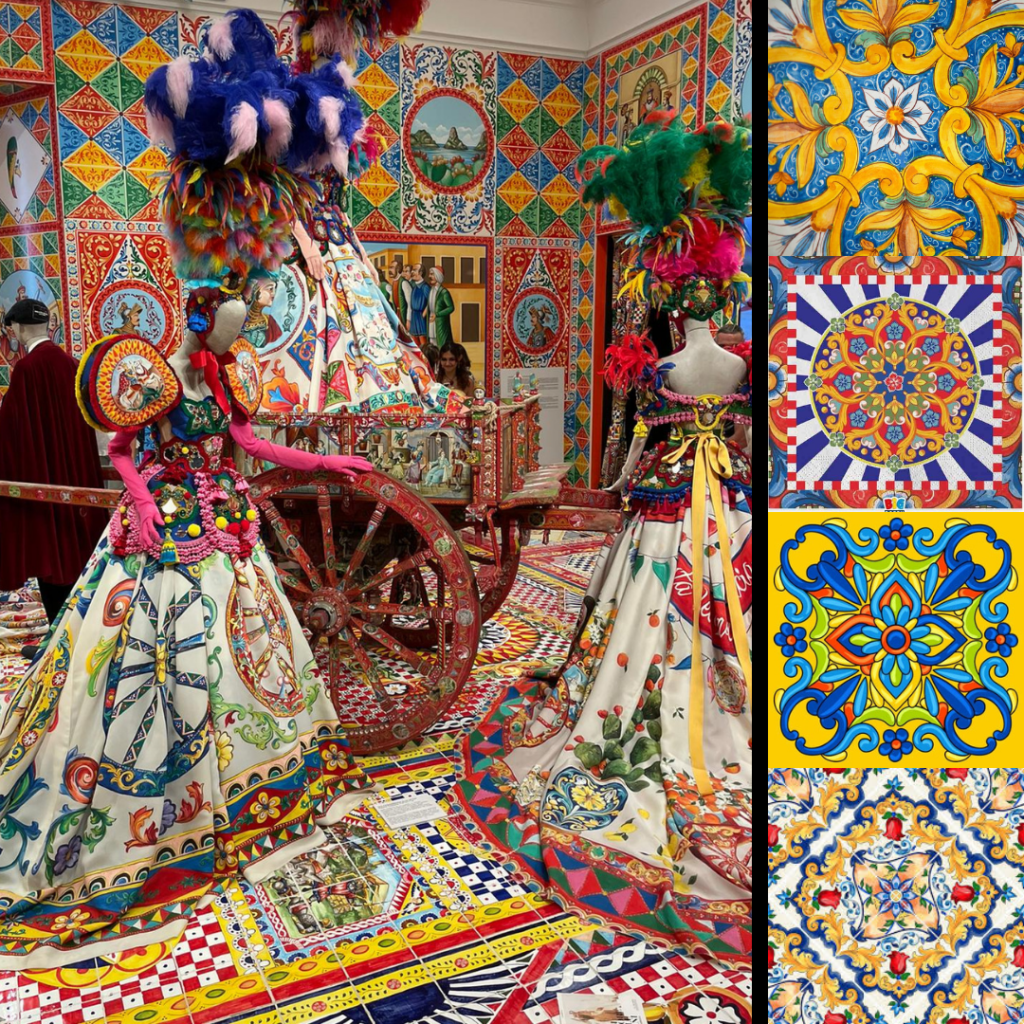
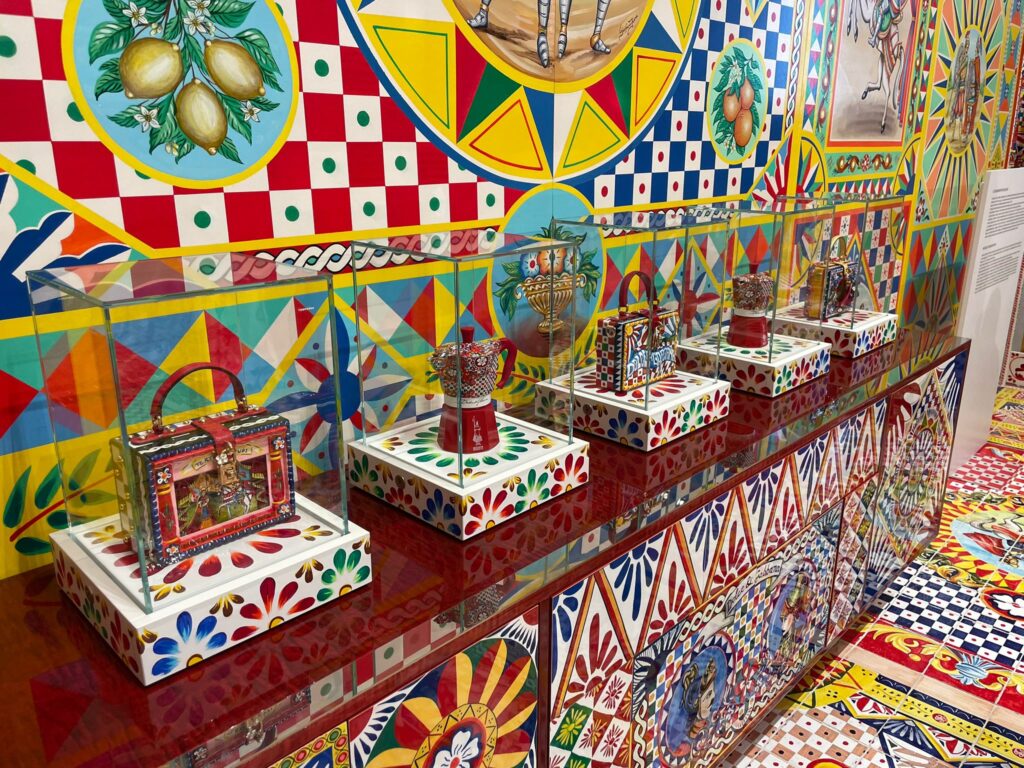
White Baroque
The eighth room is a tribute to Giacomo Serpotta, master of the Baroque period who became famous for working with “stucco” technique. Here you will find yourself not before dresses, but real textile sculptures, three-dimensional creations where Haute Couture is inspired by the art of the master plasterers of the 17th and 18th centuries. Dolce&Gabbana’s collection is infused with elegance and solemnity. White, recalling the color of the plaster, is also symbol of peace and purity, especially in the Western tradition. It evokes the absence of dust and dirt. It is pure light, the color that contains all the shades of the color spectrum, reflecting them all. White is above all simplicity, a simplicity which, in this specific installation, creates a sort of visual contrast with the luxurious opulence of the dresses. Actually this comes only apparently, as the impression visitors have is that clothes have been transformed into true masterpieces to admire.
Dream of Divinity
The ninth room presents a double scenary: on a hand, the famous Valley of the Temples in Agrigento, with divinities and mythological figures and, on the other hand, the Byzantine period with its elegant and precious mosaics. In this case, Dolce and Gabbana aim to underline the delicacy and power of femininity, which the designers express through beautiful kimonos, draped tunics, corseted dresses, suits embroidered with lurex brocade inlays. The installation reflects the dimension of the myth, of the opulence and the dream. Some details, in particular, cannot escape the eye of art and history enthusiasts: Greek deities materialize under the form of ethereal dresses, whose embroideries depict scenes of the Magna Graecia. Not only were the designers so meticulous in translating the setting into wearable pieces, but they also proved great accuracy in the selection of the colors, especially those related to yellow and ocher shades. Yellow ocher is a natural pigment that men have been using since prehistoric times. It is obtained by grinding a substance from the earth, the iron hydroxide, which turns Red upon calcification. The ancient Greeks and Romans would dye fabrics using this vibrant colors, following techniques they had previously learnt from the Phoenicians and the Assyrians, populations who lived in the present-day territories of Lebanon and Syria around 1200 BC. What a privilege to recall our cultural heritage while admiring the beauty and the perfection of Dolce&Gabbana’s creations!
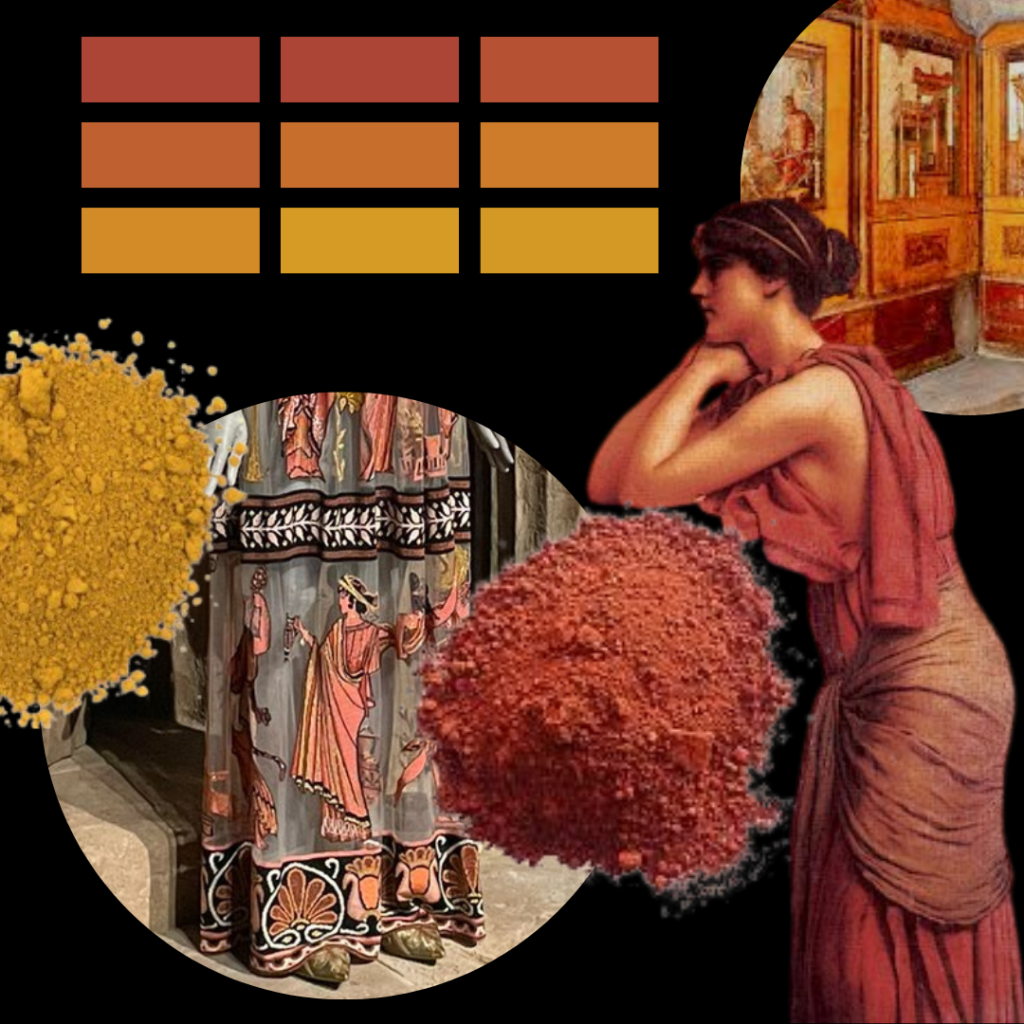

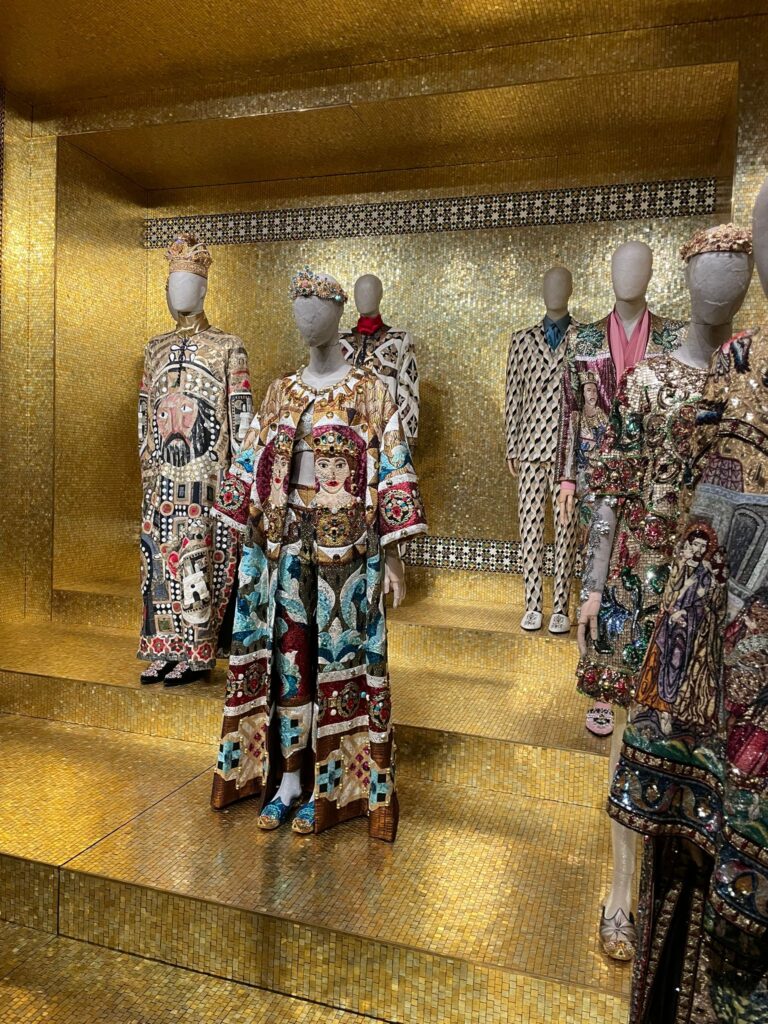
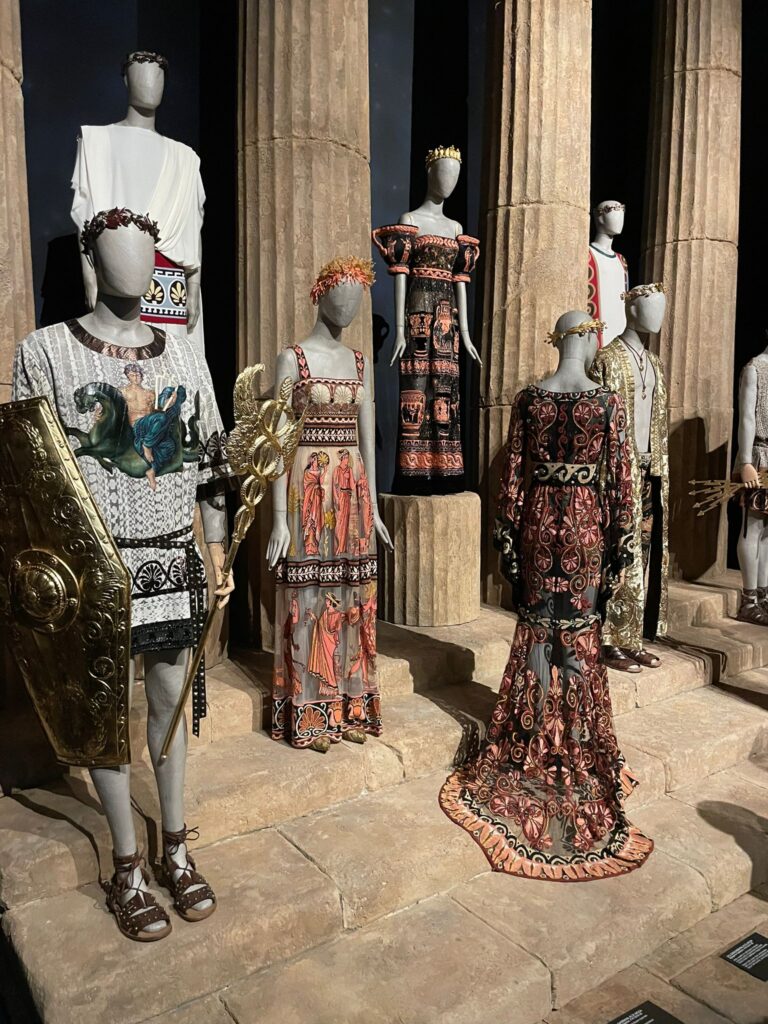
Opera
The exhibition ends with a remarkable tribute to the Italian Opera, which visitors can see entering in the tenth and last room. Like skilled orchestra directors, the designers orchestrate an extraordinary fashion performance, where each piece is a living work of art. The models displayed in this room, all inspired by opera and ballet, are distributed around a set table. The setup recalls another theme dear to the stylists: good food and conviviality, expressions of the soul of the Bel Paese and of the most authentic Italianness.


